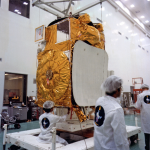
On 30 August 1983, Indian communications satellite INSAT-1B was launched from the Kennedy Space Center, Florida, USA. Important satellites launched by ISRO are crucial for the science and technology segments of the UPSC Syllabus.
INSAT-1B Details
- INSAT-1B was part of the INSAT or the Indian National Satellite System satellites which is a series of communication satellites.
- INSAT-1B was built by Ford Aerospace and operated by the Indian Space Research Organisation (ISRO).
- It was deployed by the Challenger space shuttle from the Kennedy Space Center of NASA.
- When launched, it had a mass of 1152 kg and an expected life of 7 years.
- INSAT-1A was the first satellite in the INSAT series to be launched by ISRO in April 1982, but it had to be abandoned a year later due to some technical glitches.
- INSAT-1B also ran into some trouble early on regarding the deployment of its solar array, but it became operational in October 1983 after the problem was fixed by ISRO and Ford.
- The satellite was operated in a geostationary orbit at a longitude of 74o east replacing the INSAT-1A.
- INSAT-1B had the International Designation (COSPAR designation – international naming convention for satellites) 1983-089B and a Satellite Catalog Number of 14318.
- It had 12 C band and 3 S band transponders.
- It provided direct television and communications to the entire country including remote villages. It also provided weather forecasting and disaster warning services.
- To enable the INSAT-1B to transmit programmes, around 35000 earth receive only terminals were built.
- After 7 years, in July 1990, the INSAT-1B was replaced by the INSAT-1D when the former was relegated to backup status.
- It was finally removed from the geostationary orbit and put into the graveyard orbit in August 1993.
- The satellite has transmitted to earth around 36000 earth images.
About INSAT
- The INSAT series is the largest domestic communications system in the Asia Pacific region.
- It has purposes in broadcasting, telecommunications, meteorology and search and rescue operations.
- It is a joint venture of the Departments of Space, Telecommunications, AIR, Doordarshan and the India Meteorological Department.
- It is a member of the International Cospas-Sarsat Programme.
Also on this day
1569: Mughal Emperor Jahangir (son of Akbar) was born at Fatehpur Sikri. 1574: Guru Ram Das becomes the fourth Sikh Guru. 1659: Aurangzeb executed his elder brother Dara Shikoh to reach the throne of the Delhi Mughal Empire. 1936: Madam Bhikaji Cama passed away in Bombay. 1979: Lord Mountbatten (last Viceroy of British India) was killed by the Irish Republican Army which had planted a bomb in his fishing boat in Ireland. 1990: Prasar Bharati bill passed unanimously in Parliament. 1992: The first Indian-built Advanced Light Helicopter flown in Bangalore.
See previous ‘This Day in History’ here.
For more related articles visit the links given in the table below:

Comments